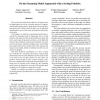Free Online Productivity Tools
i2Speak
i2Symbol
i2OCR
iTex2Img
iWeb2Print
iWeb2Shot
i2Type
iPdf2Split
iPdf2Merge
i2Bopomofo
i2Arabic
i2Style
i2Image
i2PDF
iLatex2Rtf
Sci2ools
FOCS
2004
IEEE
2004
IEEE
On the Streaming Model Augmented with a Sorting Primitive
The need to deal with massive data sets in many practical applications has led to a growing interest in computational models appropriate for large inputs. The most important quality of a realistic model is that it can be efficiently implemented across a wide range of platforms and operating systems. In this paper, we study the computational model that results if the streaming model is augmented with a sorting primitive. We argue that this model is highly practical, and that a wide range of important problems can be efficiently solved in this (relatively weak) model. Examples are undirected connectivity, minimum spanning trees, and red-blue line segment intersection, among others. This suggests that using more powerful, harder to implement models may not always be justified. Our main technical contribution is to show a hardness result for the "streaming and sorting" model, which demonstrates that the main limitation of this model is that it can only access one data stream at ...
| Added | 20 Aug 2010 |
| Updated | 20 Aug 2010 |
| Type | Conference |
| Year | 2004 |
| Where | FOCS |
| Authors | Gagan Aggarwal, Mayur Datar, Sridhar Rajagopalan, Matthias Ruhl |
Comments (0)

